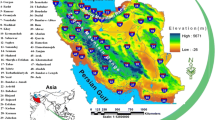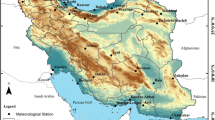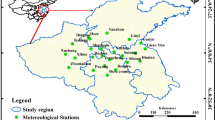Abstract
New York State (NYS) is a geographically diverse area susceptible to climate change, but trends in climate extreme indicators have not been extensively studied. Our objectives are to describe temporal and spatial trends in various extreme indicators and their sensitivity to climate change and to demonstrate geographic differences in indicator trends in NYS. We analyzed data from the US Historical Climatology Network for NYS from 1948 to 2008. We assessed trends in 15 temperature and 11 precipitation indicators using linear regression with bootstrapping in SAS and RClimDex software. The indicators showing the most substantial change per decade were frost days (−0.97 days per decade) and diurnal temperature (−0.11°C). For precipitation indicators, the number of heavy precipitation days (+0.99 days), consecutive wet days (+ 0.42 days), the total wet day precipitation (+30.19 mm), and the simple daily intensity index (+0.18 mm/day) showed the most change per decade. The most representative indicators that showed significant trends for more than half of the stations were number of cool nights, diurnal temperature, and number of frost days and increase in total wet day precipitation and simple daily intensity index for precipitation. The most sensitive regions for changes in extreme indicators were the eastern and Great Lakes regions of NYS. In light of these consistent temporal trends of warming and increasing precipitation in NYS with large geographic variation, the indicators that have been identified should be further evaluated and assessed for their health impact. Geographical differences in climate trends may be of use in informing policy and resource allocation for climate change adaptation.



Similar content being viewed by others
References
Alexander LV, Zhang X, Peterson TC et al. (2006) Global observed changes in daily climate extremes of temperature and precipitation. J Geophys Res 111:D05109. doi:10.1029/2005JD006290
Bacon RM, Kugeler KJ, Mead PS, Centers for Disease Control and Prevention (2008) Surveillance for Lyme disease—United States, 1992–2006. MMWR Surveill Summ 57(10):1–9
Beggs PJ, Bambrick HJ (2005) Is the global rise of asthma an early impact of anthropogenic climate change? Environ Health Perspect 113(8):915–919
Brown PJ, Bradley RS, Keimig FT (2010) Changes in extreme climate indices for the northeastern United States, 1870–2005. J Clim 23:6555–6572
Brownstein JS, Holford TR, Fish D (2003) A climate-based model predicts the spatial distribution of the Lyme disease vector Ixodes scapularis in the United States. Environ Health Perspect 111(9):1152–1157
Curriero FC, Patz JA, Rose JB et al (2001) The association between extreme precipitation and waterborne disease outbreaks in the United States, 1948–1994. Am J Publ Health 91(8):1194–1199
DeGaetano AT, Allen RJ (2002) Trends in twentieth-century temperature extremes across the United States. J Climate 15(22):3188–3205
dos Santos CAC, Neale CMU, Rao TVR et al (2011) Trends in indices for extremes in daily temperature and precipitation over Utah, USA. Int J Climatol 31:1813–1822
Drayna P, McLellan SL, Simpson P et al (2010) Association between rainfall and pediatric emergency department visits for acute gastrointestinal illness. Environ Health Perspect 118(10):1439–1443
Frich P, Alexander LV, la-Marta P et al (2002) Observed coherent changes in climatic extremes during the second half of the twentieth century. Climate Res 19(3):193–212
Frumhoff PC, McCarthy JJ, Melillo JM et al (2008) An integrated climate change assessment for the Northeast United States. Mitigation and Adaptation Strategies for Global Change 13(5–6):419–423
Griffiths ML, Bradley RS (2007) Variations of twentieth-century temperature and precipitation extreme indicators in the northeast United States. J Clim 20(21):5401–5417
Hunter PR (2003) Climate change and waterborne and vector-borne disease. J Appl Microbiol 94:37S–46S
Kiktev D, Sexton DMH, Alexander L et al (2003) Comparison of modeled and observed trends in indices of daily climate extremes. J Climatol 16(22):3560–3571
Mahmood R, Hubbard KG, Carlson C (2004) Modification of growing-season surface temperature records in the northern great plains due to land-use transformation: verification of modelling results and implication for global climate change. Int J Climatol 24(3):311–327
New M, Hewitson B, Stephenson DB et al. (2006) Evidence of trends in daily climate extremes over southern and west Africa. J Geophys Res Atmos 111:D14102. doi:10.1029/2005JD006289
Nicholls N, Alexander L (2007) Has the climate become more variable or extreme? Progress 1992–2006. Prog Phys Geogr 31(1):77–87
Peterson TC, Zhang XB, Brunet-India M et al. (2008) Changes in North American extremes derived from daily weather data. J Geophys Res Atmos 113:D07113. doi:10.1029/2007JD009453
Tank AMGK, Wijngaard JB, Konnen GP et al (2002) Daily dataset of 20th-century surface air temperature and precipitation series for the European Climate Assessment. Int J Climatol 22(12):1441–1453
Tank AMGK, Peterson TC, Quadir DA et al. (2006) Changes in daily temperature and precipitation extremes in central and south Asia. J Geophys Res Atmos 111(D16)
Tank AMGK, Zwiers FW, Zhang X (2009) Guidelines on Analysis of extremes in a changing climate in support of informed decisions for adaptation. WMO-TD No. 1500:1–56
Thomas KM, Charron DF, Waltner-Toews D et al (2006) A role of high impact weather events in waterborne disease outbreaks in Canada, 1975–2001. Int J Environ Health Res 16(3):167–180
Trenberth KE, Jones PD, Ambenje P et al. (2007) Observations: surface and atmospheric climate change. In: Solomon S, Qin D, Manning M, Chen Z, Marquis M, Averyt KB, Tignor M, Miller HL (eds.) Climate Change 2007: The Physical Science Basis. Contribution of Working Group I to the Fourth Assessment Report of the Intergovernmental Panel on Climate Change. Cambridge University Press, Cambridge, United Kingdom and New York, NY, USA
von Storch H and Zwiers FW (1999) Statistical Analysis in Climate Research 484
Williams CN, Vose RS, Easterling DR et al. (2006) United States historical climatology network daily temperature, precipitation, and snow data. ORNL/CDIAC-118, NDP-070 Oak Ridge, Tenn : Carbon Dioxide Information Analysis Center, Oak Ridge National Laboratory
World Meteorological Organization (2010) WMO statement on the status of the global climate in 2009 1055
Zhang XB, Yang F (2004) RClimDex (1.0) User Manual 1–23
Zhang XB, Hegerl G, Zwiers FW et al (2005) Avoiding inhomogeneity in percentile-based indices of temperature extremes. J Climatol 18(11):1641–1651
Zhang X, Zwiers FW, Hegerl G (2009) The influences of data precision on the calculation of temperature percentile indices. Int J Climatol 29(3):321–327
Acknowledgments
We thank Barbara Fletcher for her help in drafting of the manuscript. This research study was supported in part by grant #5U01EH000396-01 (NY) National Center for Environmental Health, Center for Disease Control and grant # 5U38EH000184-05 National Environmental Public Health Tracking Program, Centers for Disease Control and Prevention. The meteorological data were provided by the National Center for Atmospheric Research which is supported by grants from the National Science Foundation.
Author information
Authors and Affiliations
Corresponding author
Appendices
Appendix A1
Fig. 3
Appendix A2
Rights and permissions
About this article
Cite this article
Insaf, T.Z., Lin, S. & Sheridan, S.C. Climate trends in indices for temperature and precipitation across New York State, 1948–2008. Air Qual Atmos Health 6, 247–257 (2013). https://doi.org/10.1007/s11869-011-0168-x
Received:
Accepted:
Published:
Issue Date:
DOI: https://doi.org/10.1007/s11869-011-0168-x




